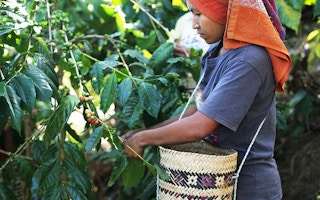Food manufacturers may soon be able to tell consumers exactly which farm their cashew nuts were grown in, with the help of a new traceability tool developed by Olam International for its clients.
Unveiled Tuesday at a launch event at its Singapore headquarters, AtSource is a digital dashboard for Olam customers to review supplier sustainability, keep track of environmental impacts in their supply chains, identify areas for improvement, and meet sustainability targets.
“The intractable problem we’re trying to solve is how are we going to increase food production to feed a growing population, as well as the changing dietary habits of this population,” said Sunny Verghese, chief executive officer of Olam.
He said that around half of the world’s hungry are themselves smallholder farmers, yet still go to bed with empty stomachs each night - proof that the current system of smallholder farming is broken.
“Developing sustainable, enduring supply chains without eroding the planet’s capacity to feed future generations is the challenge,” Verghese said.
Olam customers can pick from one of three different AtSource tiers.
At the most basic, free-to-use level, AtSource lists suppliers that comply with the Olam Supplier Code, and allows users to understand their environmental impact through an Eco-Calculator that displays climate change, water and land use risks for each country.
One step above that is AtSource Plus, where Olam clients who opt in have access to more detailed information about the agricultural operations of their supplier farmers. These details are focused on 12 core sustainability topics and 80 indicators, to address persistent issues such as soil health and child labour. Based on the client’s sustainability priorities, the system helps them to find weaknesses in the supply chain or farming operations.
The highest tier, AtSource Infinity, is meant for customers who want to create a “net positive impact” on the agriculture industry. Olam and AtSource Infinity clients will co-create programmes to benefit farming populations and environments.
AtSource also includes an Impact Stories section which, depending on the origin of the client’s product purchase, features case studies of how sustainable agriculture has benefited communities and can help brands connect with the end consumer.
Christopher Stewart, Olam’s head of corporate responsibility and sustainability, told Eco-Business that all three tiers would provide transparency and assurance about Olam’s suppliers.
However, he added that the improved farming practices, training programmes and building of clinics, schools and infrastructure to ensure granularity and traceability come with a cost. “When we commence a new programme, what we’d like to do is share the costs with our customers and show them directly how we work with those particular farmer groups. Many of our customers then feel a sense of ownership over those programmes,” said Stewart.
He commented that the food manufacturing companies that form Olam’s client base have set ambitious targets such as carbon neutrality, but are seldom close enough to farmers to make changes on the ground, which is where Olam can help.
Verghese explained that the different tiers were meant to cater to its clients - such as food manufacturers who buy their raw supplies from Olam - who may be at different stages of the sustainability journey. The price of using the B2B product will vary as AtSource Plus and Infinity are tailored to customer needs, he added.
AtSource will begin offering traceability with five product supply chains, namely cocoa and cashew from Cote d’Ivoire, coffee from Brazil and Vietnam, and onions and garlic from the United States. More supply chains will be introduced as the programme expands.
The data about farming operations provided on AtSource is supplied by Olam’s previous programmes including the Olam Farmer Information System. But with 4.7 million farmers in the agri-business giant’s supply chain by its own count, achieving complete traceability is a tall order; Olam does not have full visibility through its operations yet.
Addressing this concern, Stewart admitted that Olam “doesn’t have all the answers about how to do this for 4.7 million farmers,” but will be collaborating with partners to develop new methodologies and expand existing programmes to gather more data.
Olam aims to have 100 per cent of its products and ingredients to be traceable and “AtSource ready” by 2025.
“Our hope is that the end consumer will have full visibility and traceability, right to the small farmer,” said Verghese.

















